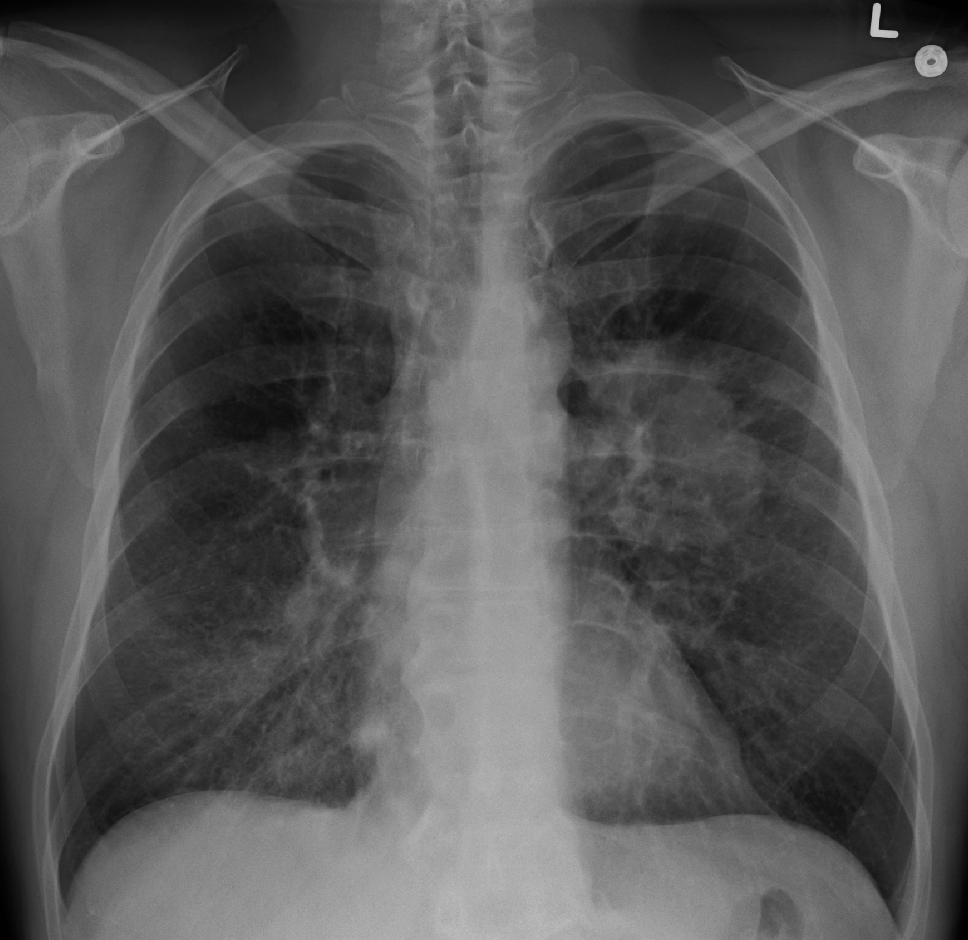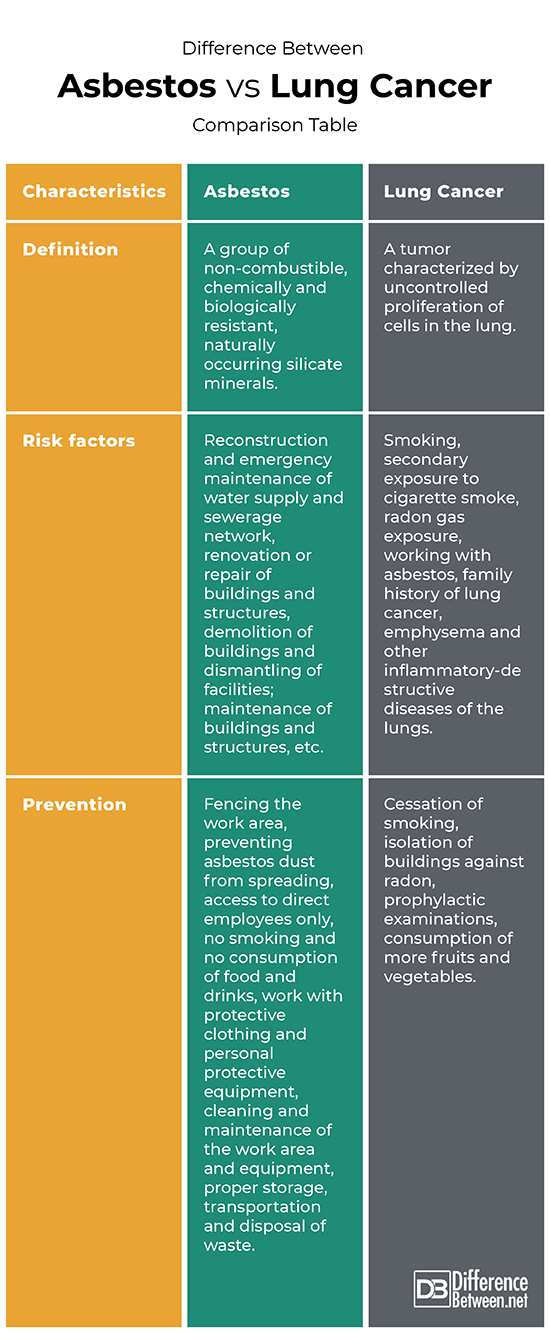Difference Between Asbestos and Lung Cancer
Asbestos is a group of fibrous minerals used in construction, industry, and fire safety. It is carcinogenic and there is no safe level of asbestos dust. There is a well-established link between asbestos exposure and lung cancer. For this reason, the use of asbestos is now forbidden in many countries.
What is Asbestos?
Asbestos is the common name for a group of naturally occurring non-combustible, chemically and biologically resistant silicate minerals, an excellent electrical insulator. Its qualities determined its widespread use in construction, industry, and fire safety. The boom in its use is in the 70s and 80s of the 20th century.
Asbestos is carcinogenic and there is no safe level of exposure to asbestos dust. It consists of microfibers with sharp edges, which can be released into the atmosphere by abrasion and other processes. When inhaled, the microfibers of asbestos remain in the lungs and cannot be discharged by coughing or otherwise. They are harmful to health and cause lung disease, some of which – incurable. Contact with asbestos can provoke complications in other organs and systems in the human body.
Due to its adverse impacts on human health, the use of asbestos is now forbidden in many countries. However, this does not solve the problem of asbestos already used in buildings and structures.
Typical places where asbestos-containing materials may be used include:
- Isolation on various facilities, eternite pipes, heating systems with thermal insulation of pipelines and boilers, electrical installations;
- Reinforcing materials, roof tiles, cladding tiles;
- Flooring, asbestos-paper lining;
- Valves, flanges, and gaskets, lined or insulated with asbestos, etc.
Risk activities related to exposure to asbestos are:
- Reconstruction and emergency maintenance of water supply and sewerage network;
- Renovation or repair of buildings and structures;
- Demolition of buildings and dismantling of facilities;
- Maintenance of buildings and structures, etc.
The prevention of the harmful effects of asbestos includes:
- Fencing the work area and marking with warning signs;
- Preventing asbestos dust from spreading;
- Access to direct employees only;
- No smoking and no consumption of food and drinks;
- Suitable service premises, including showers, for dust removal operations;
- Work with protective clothing and personal protective equipment;
- Regular and efficient cleaning of the work area and equipment;
- Proper storage, transportation, and disposal of waste.
What is Lung Cancer?
Lung cancer is a tumor characterized by uncontrolled proliferation of cells in the lung. This diagnosis includes more than 10 different diseases with different histology, course, and prognosis. The formations are made up of different cells and occur in different regions of the lung. From a histological point of view, the lung cancer can be small and non-small-cell lung cancer.
Lung cancer develops most commonly in the bronchial mucosa, but it can start from anywhere in the respiratory system – the alveoli, trachea, or small bronchioles.
The most common symptoms are:
- Appearance of a new persistent cough that is not treatable;
- Changes in the usual tobacco or chronic cough;
- Occurrence of blood in the phlegm;
- Whistling in the chest;
- Shortness of breath – differently expressed and/or altered than before;
- Pneumonia;
- Pleural effusion;
- Voice changes;
- Symptoms and signs after metastasis depending on the location of the metastases;
- Paraneoplastic syndromes, etc.
Recognized and proven risk factors are:
- Smoking – the risk of developing lung cancer is directly proportional to the number of cigarettes smoked per day and the duration of the habit in years;
- Secondary exposure to cigarette smoke;
- Radon gas exposure;
- Working with asbestos;
- Family history of lung cancer;
- Emphysema and other inflammatory-destructive diseases of the lungs.
Imagery studies are the first step to diagnosing lung cancer. While radiography is an indicative study, computed tomography, magnetic resonance imaging, and positron emission tomography give a more detailed image of the structures and processes in the chest. After localizing cancer and evaluating its distribution in the body, the final decisive step in the diagnostic process is the biopsy of an accessible formation and the histological evaluation of the biopsy material.
Treatment may include:
- Radiation therapy;
- Chemotherapy;
- Hormonal therapy;
- Targeted therapy;
- Surgery.
The prevention includes:
- Cessation of smoking;
- Isolation of buildings against radon;
- Prophylactic examinations;
- Consumption of more fruits and vegetables.
Difference Between Asbestos and Lung Cancer
Definition
Asbestos: Asbestos is the common name for a group of naturally occurring non-combustible, chemically and biologically resistant silicate minerals.
Lung Cancer: Lung cancer is a tumor characterized by uncontrolled proliferation of cells in the lung. This diagnosis includes more than 10 different diseases with different histology, course, and prognosis.
Risk factors
Asbestos: Risk activities related to exposure to asbestos are reconstruction and emergency maintenance of water supply and sewerage network; renovation or repair of buildings and structures; demolition of buildings and dismantling of facilities; maintenance of buildings and structures, etc.
Lung Cancer: Recognized and proven risk factors for lung cancer are smoking, secondary exposure to cigarette smoke, radon gas exposure, working with asbestos, family history of lung cancer, emphysema and other inflammatory-destructive diseases of the lungs.
Prevention
Asbestos: The prevention of the harmful effects of asbestos includes fencing the work area, preventing asbestos dust from spreading, access to direct employees only, no smoking and no consumption of food and drinks, work with protective clothing and personal protective equipment, cleaning and maintenance of the work area and equipment, proper storage, transportation and disposal of waste.
Lung Cancer: The prevention of lung cancer includes cessation of smoking, isolation of buildings against radon, prophylactic examinations, consumption of more fruits and vegetables.
Difference Between Asbestos Vs Lung Cancer: Comparison table
Summary:
- Asbestos is the common name for a group of naturally occurring non-combustible, chemically and biologically resistant minerals.
- Lung cancer is a tumor characterized by uncontrolled proliferation of cells in the lung.
- There is a well-established link between asbestos exposure and lung cancer. For this reason the use of asbestos is now forbidden in many countries.
- Risk activities related to exposure to asbestos are reconstruction and emergency maintenance of water supply and sewerage network, renovation or repair of buildings and structures, demolition of buildings and dismantling of facilities, maintenance of buildings and structures, etc.
- Recognized and proven risk factors for lung cancer are smoking, secondary exposure to cigarette smoke, radon gas exposure, working with asbestos, family history of lung cancer, emphysema and other inflammatory-destructive diseases of the lungs.
- The prevention of the harmful effects of asbestos includes fencing the work area, preventing asbestos dust from spreading, access to direct employees only, no smoking and consumption of food and drinks, work with protective clothing and personal protective equipment, cleaning and maintenance of the work area and equipment, proper storage, transportation and disposal of waste.
- The prevention of lung cancer includes cessation of smoking, isolation of buildings against radon, prophylactic examinations, consumption of more fruits and vegetables.
- Difference Between Gallstones and Cholecystitis - September 5, 2021
- Difference Between Constipation and Cramping - August 4, 2021
- Difference Between Whole Genome Sequencing and Microarray - May 6, 2021
Search DifferenceBetween.net :
Leave a Response
References :
[0]Bozzano, L. Asbestos and Disease. 1st Edition. Amsterdam: Elsevier. 1979. Print.
[1]Warrell, D., T. Cox, J. Firth. Oxford Textbook of Medicine, Vol. 2. Oxford: Oxford University Press. 2010. Print.
[2]Yankova, Z. New Guide to Pulmonary Diseases and Tuberculosis. Sofia: Medical University Press. 2012. Print.
[3]Image credit: https://commons.wikimedia.org/wiki/File:Lung_Cancer_on_Chest_X-Ray.jpg
[4]Image credit: https://live.staticflickr.com/65535/47098414854_848706aa50_b.jpg



